
play back the same sequence of moves over and over. This is a
great way to add variety to demonstration or self-running train
layouts. I plan on using this controller to operate the layout we
maintain at the Children’s Hospital of Pittsburgh. Rather than just
having the trains run in a simple loop, the controller’s recording
will have the trains running, stopping, and reversing.
Control options
One of the most difficult tasks one faces when designing a
microcontroller-based device is creating a user interface that
allows the operator to operate the unit with ease. Because
the PICAXE 18M2 has the ability to interpret and act on codes
sent from a TV remote control, the user interface can be both
full-featured and easy to use. The remote shown in figure 2
is a Westinghouse unit that sends the Sony codes the PICAXE
is programmed to interpret. Most Sony and multi-brand pro-
grammable remote controls will work. It is possible that some
of the buttons will not match those shown here, but is it a sim-
ple matter to modify the program code to work with another
remote control [2].
This TV remote control’s buttons are used as follows:
Channel Up – increase speed
Channel Down – decrease speed
Volume > or < – change direction
Menu – stop, remembering speed, or start at the stored
speed after a stop
Return – enter configuration mode
Number Keys 1-0 – enter configuration data while in configu-
ration mode
2
2. Example Westinghouse brand remote that can
send the Sony codes the PICAXE is programmed to
interpret.
Using the Controller
The video below shows many of capabilities of the controller.
PICAXE circuit - 3
MRH-Jun 2014


